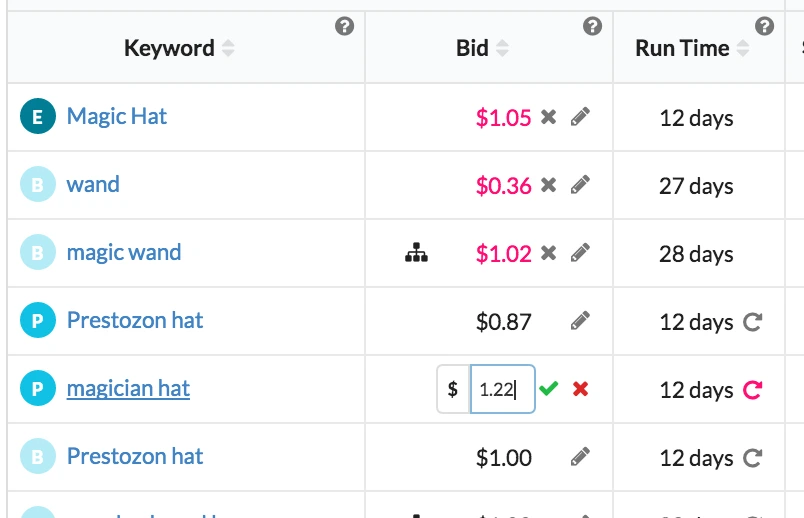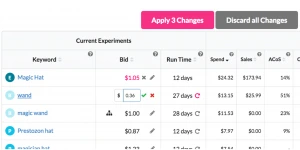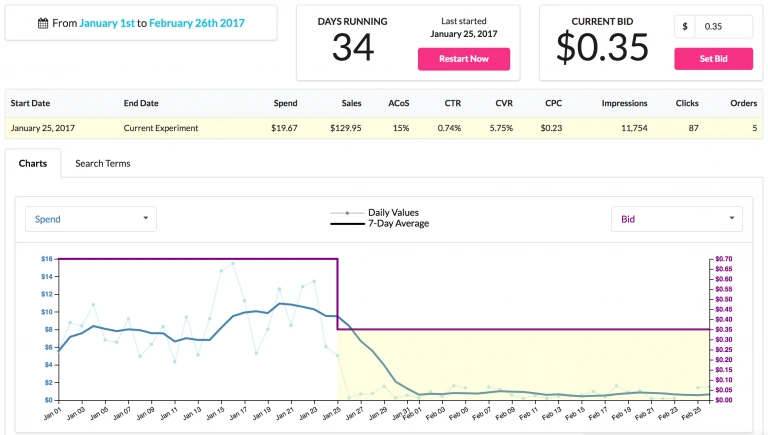
Bid Wizard: Optimize Your Ad Campaigns Faster

Table of Contents
- Quick start
- How do I use the Bid Wizard?
- What is an experiment?
- Gather Enough Data
- Know your goals
- Take Action Quickly and Regularly
- Why do you need to refresh experiments?
- In Summary
Managing your Amazon ad campaigns is important. Without making regular keyword and bid updates, you’ll be wasting a lot of money on bad keywords and losing out on more sales from your good keywords.
The problem is that using the tools and reports available in Seller Central for managing Sponsored Products campaigns is not ideal. You know why:
- Seller Central doesn’t track bid changes, so you have to do that on your own
- If you do track when you changed the bids, you then need to subset the Campaign Performance Report for each keyword and for each bid change.
- The Search Term Report can’t be split up by bid change at all, so you’re left blind about how search terms reacted to a bid change
Prestozon Bid Wizard solves all of these problems and makes it amazingly easy to make well informed, timely bid changes. Here’s how to use it.

Quick start
We recommend reading the entire guide so that you absorb the logic behind this optimization method. But to get you started quickly, here are the basics.
How do I use the Bid Wizard?
The Bid Wizard is designed to help you make the best decisions as fast as possible. There are just three steps: Sort, Decide, Apply Changes.
- Sort: The keywords are sorted by ad spend by default. This means that the keywords on top are the most important ones to adjust — they drive the most spend.
- Decide: For every keyword that has enough data, take one of these actions:
- If the keyword is not profitable, decrease the bid.
- If it’s profitable and you want more impressions, increase the bid.
- If it is performing exactly as you want, restart the data collection at the same bid. (More on this later in the guide.)
- Apply: Apply all changes. You’re well on your way to more profits.
What is an experiment?
Experiments help you find the optimal keyword bid. Experiments isolate a time period of a specific bid so you can see its performance and compare it to previous bids. You should be testing bids all the time to optimize the money you spend on ads and to adjust as the market for each keyword changes over time.

But how can you compare bids if Amazon doesn’t save your bid history? And how long should you wait before changing bids? Prestozon Bid Wizard tracks experiments and presents the ones with the most data so you can make rapid decisions.
Think of changing a bid as “starting an experiment.” Every keyword always has an experiment running. The key is to run an experiment until you have just enough data to understand the results: no longer and no shorter.
Tip – A good rule of thumb is 20 clicks. Once you have 20 clicks, you probably have enough data to make a bid decision. If you make updates on all of your keywords once a week, you’ll have waited too long on some keywords and you won’t be properly informed on others. With Bid Wizard, you can decide on only those keywords that have enough data. Simply sort by Clicks to see all keywords with 20+ clicks. Make decisions on each of those experiments and then leave the rest running to collect more data.
Gather Enough Data
So how do you know when you have enough data? The bare minimum is 1,300 impressions, but we suggest waiting longer than this in most cases. For a keyword that has 5% conversion rate you need at least 20 clicks before you should expect the first sale.
Know your goals
To make good decisions, you need to know your goals. Here are three common goals:
Maximizing profit per sale by lowering ACoS. Lower advertising cost per sale means more profit per item. The drawback is you’ll have to bid lower to get lower ACoS, possibly leading to fewer impressions and sales.
Maximizing total profit by balancing ACoS and volume. A slightly higher ACoS could mean more overall profit because of more impressions, clicks, and sales.
Maximum sales for a budget. Aiming for the most sales for a given budget is a great way to help launch a product because it helps you move up the organic search ranking and gets your product in a customer’s hands, possibly leading to a review. This is also a good strategy in competitive markets where maintaining search ranking determines the success of a product.
The way you should manage your bid strategy depends on this goal. It also depends on where in the product lifecycle you are. Are you just launching? You’ll want to focus less on ACoS and more on getting lots of impressions so that you can find the best keywords and get exposure to learn quickly.
Take Action Quickly and Regularly
It’s important to take action on a keyword as soon as you have enough data, either restarting the data collection or changing the bid. Take one of these actions:
Action 1: Changing the bid as soon as you have enough data means you’ll progress toward your goal much faster.
Action 2: Refreshing the experiment prevents outdated data from obscuring recent performance, meaning you can react faster. Take a look at the example below to see how looking at old data keeps you from making the right decision.
Why do you need to refresh experiments?
Imagine a scenario where you spend $100 on one keyword per week. Your profit margin is 30% so you are happy if the ACOS is lower than 30%. You are concerned if it ever breaks above 40%. This keyword is getting competitive so you check it weekly. Below are two scenarios: Never refreshing the experiment (1) and refreshing weekly (2).
| Week | Spend | Sales | Scenario 1 (Never reset) | Senario 2 (Reset weekly) |
|---|---|---|---|---|
| 1 | $100 | $500 | 20% | 20% |
| 2 | $100 | $400 | 22% | 25% |
| 3 | $100 | $300 | 25% | 33% |
| 4 | $100 | $200 | 29% | 50% |
| 5 | $100 | $200 | 31% | 50% |
| 6 | $100 | $200 | 33% | 50% |
| 7 | $100 | $100 | 37% | 100% |
| 8 | $100 | $100 | 40% | 100% |
Scenario 1 If you never reset the data accumulation you see the total performance since week 1 every time you check on the keyword. It looks like the keyword looks like it has acceptable performance up until week 5. You only start being seriously concerned by week 8.
Scenario 2 If you reset the data collection weekly you notice the problem as soon as the keyword stops performing. At week 3 you’ll notice you’re above your target ACOS and in week 4 you know you need to make a change. In scenario 1, it still looks like you’re below your target ACoS, but that’s far from true.
Conclusion – Reset data regularly, either by changing a bid or refreshing in Bid Wizard.
Tip – Notice that 8 weeks is what’s given in the Search Term Report from Amazon. If you’re using this report to make decisions then you are losing money unnecessarily. That’s what Prestozon is for.
In Summary
Bid management is the key to profitable Amazon PPC campaigns. By focusing on the highest-spend keywords and making decisions as soon as possible, you can maximize progress toward your goal.
Any questions or comments? We’d love to hear from you!
Achieve More Results in Less Time
Accelerate the Growth of Your Business, Brand or Agency
Maximize your results and drive success faster with Helium 10’s full suite of Amazon and Walmart solutions.

